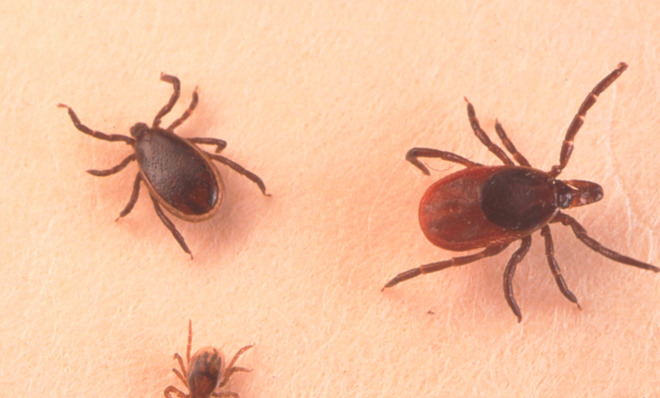The worrying rise of tick-borne diseases
A new generation of mystifying pathogens is spreading across the U.S., one little bite at a time

What makes ticks dangerous?
The little buggers are stealthy, feed on blood, and can transmit a variety of dangerous bacteria. Many ticks — which are arachnids, like spiders and mites — are barely perceptible to the naked eye, especially in the nymph stage. But their bite can pack a wallop, infecting hundreds of thousands of Americans in many regions of the country with a growing number of mysterious, debilitating, and sometimes fatal diseases. Lyme disease, for which ticks are the only known transmitter, is the most notorious. A recent study by the Centers for Disease Control and Prevention estimated that Lyme affects 300,000 Americans every year — 10 times higher than previous estimates. "We know that routine surveillance only gives us part of the picture, and that the true number of illnesses is much greater," says Dr. Paul Mead of the CDC's Lyme disease program. Typical symptoms include fever, headache, fatigue, and sometimes a bull's-eye-shaped rash, but Lyme disease can sometimes lead to more serious neurological impairments, including forms of meningitis and encephalitis. And yet Lyme might not even be the most dangerous pathogen ticks carry.
What other illnesses can ticks cause?
The Week
Escape your echo chamber. Get the facts behind the news, plus analysis from multiple perspectives.

Sign up for The Week's Free Newsletters
From our morning news briefing to a weekly Good News Newsletter, get the best of The Week delivered directly to your inbox.
From our morning news briefing to a weekly Good News Newsletter, get the best of The Week delivered directly to your inbox.
More, it seems, every year. Among them are the Heartland virus, which can trigger fever and liver abnormalities; babesiosis, which mimics the symptoms of malaria and has increased 20-fold in the lower Hudson River Valley since 2001; and perhaps worst of all, Powassan disease, which kills about 10 percent of its victims and leaves 50 percent of its survivors with lasting neurological damage. In August, the disease claimed the life of a 17-year-old from upstate New York, who suddenly collapsed in his family's yard after a deer tick bite had left him feeling achy and sluggish for two weeks. Dog ticks, found east of the Rockies and in parts of California, can transmit Rocky Mountain spotted fever, which can also be fatal. In June, a 6-year-old girl from North Carolina died after being diagnosed with the disease.
Why are these diseases so difficult to treat?
Patients often don't realize they've been bitten, and doctors often fail to diagnose the infections quickly or accurately. In fact, health officials only recently figured out that deer ticks transmit not just the Borrelia burgdorferi bacterium that causes Lyme, but five other types of bacteria. One of them is Borrelia miyamotoi, which causes an unnamed illness with symptoms that very closely resemble Lyme's. This may explain why doctors have been puzzled for decades by some patients who continue to feel sick even after antibiotics appear to eradicate the Lyme infection; now it seems likely these patients were also suffering from undetected infections by other bacteria. Perhaps the strangest set of symptoms from tick bites is the outbreak of bewildering "meat allergies" that began affecting people in 2007.
Meat allergies?
A free daily email with the biggest news stories of the day – and the best features from TheWeek.com
Yes. Virtually overnight, more than 1,000 people who'd eaten meat all their lives suddenly erupted in hives and suffered breathing difficulties and vomiting after consuming beef, pork, or lamb. Allergy specialists Thomas Platts-Mills and Scott Commins of the University of Virginia tracked the outbreak, and zeroed in on a mystifying culprit: The voracious lone star tick, whose bite can trigger production of an antibody that causes a violent allergic reaction when encountering a sugar found in red meat. "I didn't have no idea what was causing it," said Robby Bryant, a 37-year-old Kentucky resident. "It's a real, real scary situation when you can't breathe."
Can tick populations be reduced?
They can, but with only moderate effectiveness. A recent CDC study found that ticks were adapting to traditional pesticides, and that spraying the pesticide bifenthrin in a suburban area produced no decline in tick bites. So scientists are rethinking their plan of attack. Recent studies have shown that targeting deer, mice, and other host animals that the ticks live on might actually be the most effective way to curb increasingly resilient populations. Researchers say it's best to combine that tactic with spraying both chemical and natural pesticides such as fungi or rosemary extract in areas where people and ticks are most likely to meet. "Knowing how to kill ticks isn't good enough," says Rick Ostfeld, a disease ecologist at the Cary Institute of Ecosystem Studies in Millbrook, N.Y. "Figuring out where people get exposed is key."
How do you prevent bites?
Currently, there is no vaccine for Lyme disease or other tick-borne illnesses, which is why health experts say that prevention is critical. The CDC advises wearing light-colored clothing to make picking off ticks easier, and tucking your pants into socks. EPA-certified repellents containing DEET may also help, but they're hardly foolproof. Your best bet is probably to avoid wading through thick brush and high grass in wooded areas where ticks tend to concentrate, and to inspect your clothes and body carefully after outdoor activity near possible tick habitats.
The climate change boom
Climate change may play a role in surging Lyme disease rates. Yale University researchers have demonstrated a correlation between outbreaks of Lyme disease and increasingly temperate weather in the American Northeast. Deer ticks live for an average of two years and have three main life stages: larval, nymphal, and adult. During the winter, ticks usually become dormant. But warmer winters have seen ticks breeding throughout the year, increasing the populations of larvae and nymphs in the spring. Warmer and moister air may also extend the life cycle of ticks, so that nymphs — the stage most likely to transmit infections — continue to be active all summer. Lyme disease rates have shot up accordingly. Research shows that warmer temperatures may also be expanding tick habitats, and extending their life cycle to three years. "There are lots of factors that contribute," says Ben Beard, a climate change expert with the CDC. "But climate disruption and change clearly have an impact."
-
 Is MAGA melting down?
Is MAGA melting down?Today's Big Question Candace Owens, Tucker Carlson, Laura Loomer and more are feuding
-
 Kushner drops Trump hotel project in Serbia
Kushner drops Trump hotel project in SerbiaSpeed Read Affinity Partners pulled out of a deal to finance a Trump-branded development in Belgrade
-
 Son arrested over killing of Rob and Michele Reiner
Son arrested over killing of Rob and Michele ReinerSpeed Read Nick, the 32-year-old son of Hollywood director Rob Reiner, has been booked for the murder of his parents